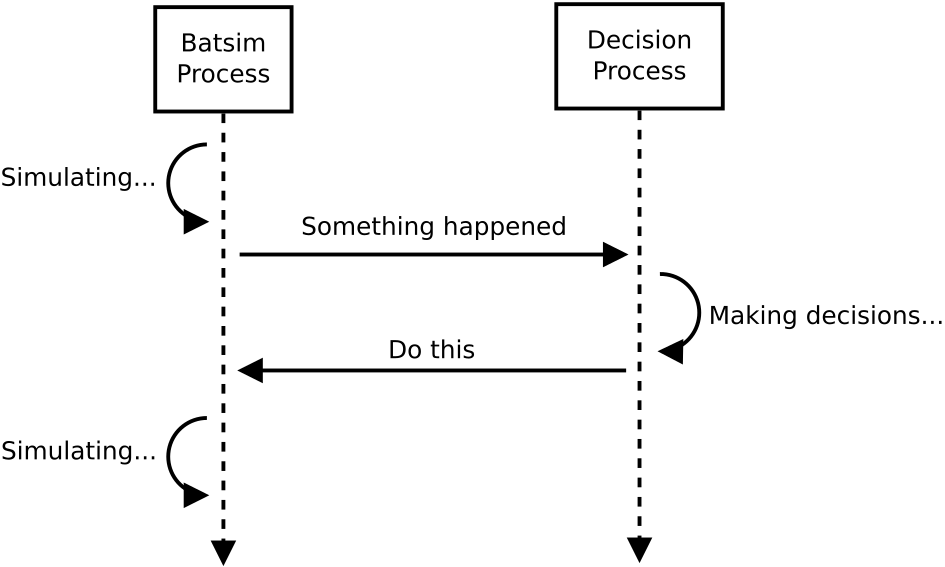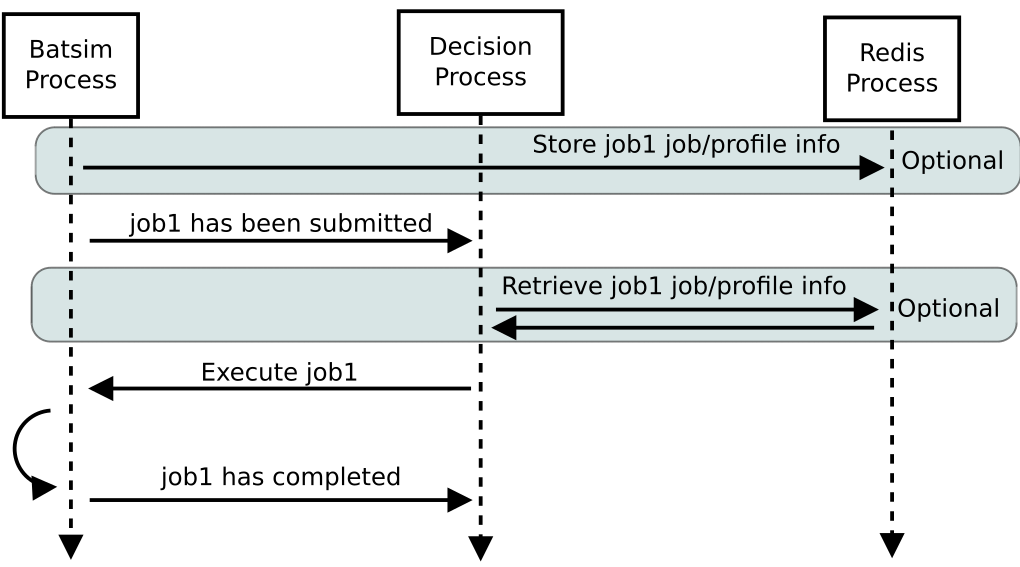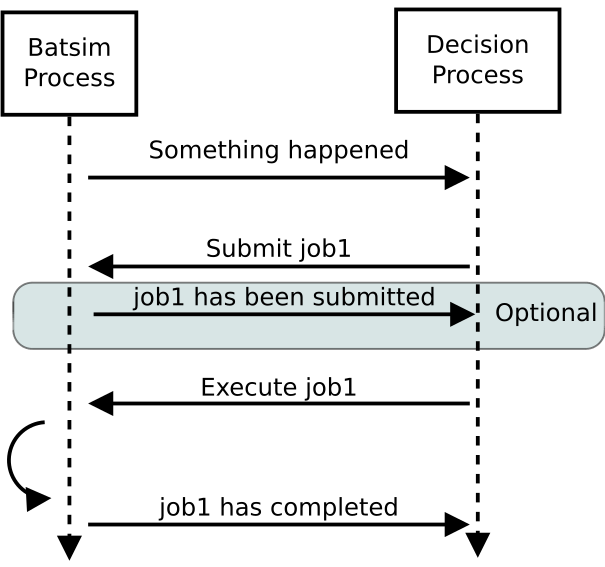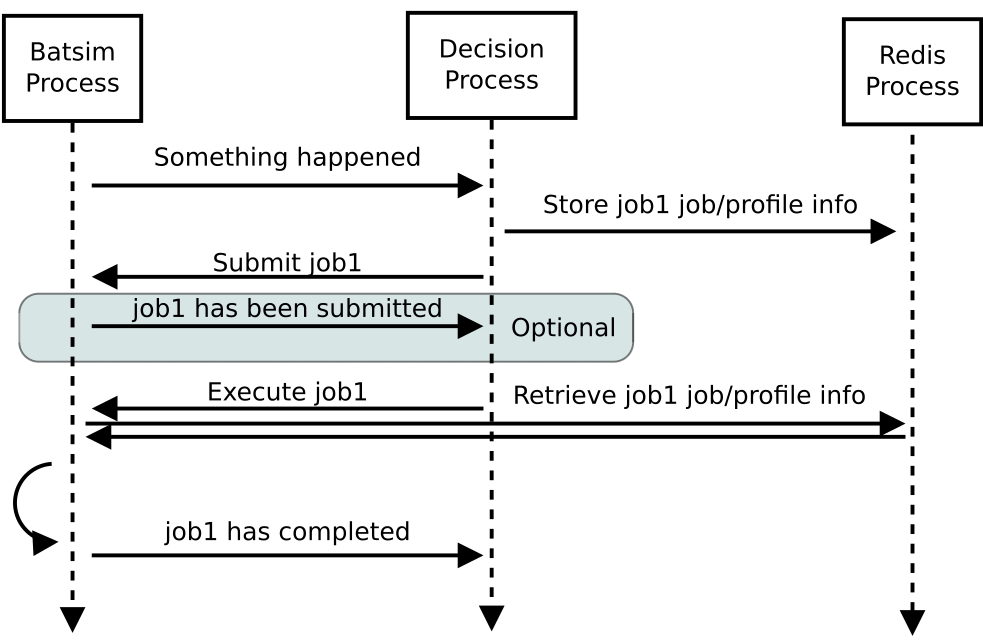Protocol
A Batsim simulation consists in two processes.
Batsim itself, in charge of simulating what happens on the platform.
A Decision Process (or more simply scheduler), in charge of making decisions.
The two processes communicate via a socket with the protocol explained in the present document. The protocol is synchronous and follows a simple request-reply pattern. Whenever an event which may require making decision occurs in Batsim in the simulation, the following steps occur.
Batsim suspends the simulation
Batsim sends a request to the scheduler (telling it what happened on the platform)
Batsim waits for a reply from the scheduler
Batsim receives the reply
Batsim resumes the simulation, applying the decision which have been made

Communication is implemented using the ZeroMQ request-reply pattern. Batsim uses a ZMQ REQ socket to send requests to the schedulers. The scheduler uses a ZMQ REP socket.
The behavior of this protocol depends on Batsim Command-line Interface.
If Redis is enabled, job metadata is stored into a Redis server and not sent through the protocol. In this case, the protocol is only used for synchronization purposes. More information about Redis conventions are described in Using Redis.
Batsim may or may not forward job profile information to the scheduler when jobs are submitted (see JOB_SUBMITTED documentation).
Dynamic jobs (and profile) registration can be enabled or disabled. Many parameters of jobs registration can be adjusted. Please refer to Dynamic registration of jobs for more details.
Message Composition
Each message is a JSON object that looks like this.
{
"now": 1024.24,
"events": [
{
"timestamp": 1000,
"type": "EXECUTE_JOB",
"data": {
"job_id": "workload!job_1234",
"alloc": "1 2 4-8",
}
},
{
"timestamp": 1012,
"type": "EXECUTE_JOB",
"data": {
"job_id": "workload!job_1235",
"alloc": "12-100",
}
}
]
}
The now field defines the current simulation time.
If the message comes from Batsim, it means that the scheduler cannot make decisions before
nowas it would change the past.If the message comes from the scheduler, it tells Batsim that the scheduler finished making its decisions at timestamp
now. This is used by Batsim to know when the scheduler will be available for making new decisions.
The events field defines a sequence of events.
The various event types are defined in the present document.
See Table of Events for a quick list.
Constraints
Constraints on the message format are defined here.
The message timestamp
nowmust be greater than or equal to every eventtimestamp.Events timestamps must be in (non-strictly) ascending order.
The following fields are mandatory in the message main object.
nowof float type.eventsof array type. Can be empty.timestampof float type.typeof string type. Value must be valid (see Table of Events).dataof object type. Value depends on the eventtype(see Table of Events).
Table of Events
Bidirectional
Batsim to Scheduler
Scheduler to Batsim
Bidirectional events
These events can be sent from Batsim to the scheduler, or in the opposite direction.
QUERY
This event allows a peer to ask specific information to its counterpart. The other peer should answer to such a QUERY via an ANSWER.
For now, Batsim answers to the following requests.
consumed_energy: The scheduler queries Batsim about the total consumed energy (from time 0 to now) in Joules. This query has no argument. Only works if the energy mode is enabled (see Command-line Interface).
For now, Batsim queries the following requests.
estimate_waiting_time: Batsim asks the scheduler what would be the waiting time of a potential job. Arguments: a job description, similar to those sent in JOB_SUBMITTED events when redis is disabled.
data: A dictionary of requests.
{
"timestamp": 10.0,
"type": "QUERY",
"data": {
"requests": {"consumed_energy": {}}
}
}
{
"timestamp": 10.0,
"type": "QUERY",
"data": {
"requests": {
"estimate_waiting_time": {
"job_id": "workflow_submitter0!potential_job17",
"job": {
"res": 1,
"walltime": 12.0
}
}
}
}
}
ANSWER
This is a reply to a QUERY event.
data: See QUERY.
{
"timestamp": 10.0,
"type": "ANSWER",
"data": {"consumed_energy": 12500.0}
}
{
"timestamp": 10.0,
"type": "ANSWER",
"data": {
"estimate_waiting_time": {
"job_id": "workflow_submitter0!potential_job17",
"estimated_waiting_time": 56
}
}
}
NOTIFY
This event allows a peer to notify something to its counterpart. There is no expected acknowledgment when sending such an event.
For now, Batsim can notify the scheduler of the following.
no_more_static_job_to_submit: Batsim tells the scheduler that it has no more jobs to submit from the static submitters. This means that all jobs in the workloads have already been submitted to the scheduler and the scheduler cannot expect more jobs to arrive (except the potential ones through dynamic submission).no_more_external_event_to_occur: Only applicable if a list of events are given as input to Batsim via the--eventscommand-line option. Batsim tells the scheduler that there is no more external event to occur from the event submitters. That means that all external events have occurred and the scheduler cannot expect a new event to occur.event_machine_unavailableorevent_machine_availableif external events are used (cf. External Events).
For now, the scheduler can notify Batsim of the following.
registration_finished: The scheduler tells Batsim that dynamic job registrations are over, therefore allowing Batsim to stop the simulation eventually. This event MUST be sent if dynamic jobs registration is enabled (see Command-line Interface).continue_registration: The scheduler tells Batsim that it has sent aregistration_finishedNOTIFY prematurely and that Batsim should re-enable dynamic registration of jobs…
data: The type of notification, as a string.
{
"timestamp": 23.50,
"type": "NOTIFY",
"data": { "type": "no_more_static_job_to_submit" }
}
{
"timestamp": 23.50,
"type": "NOTIFY",
"data": { "type": "no_more_external_event_to_occur" }
}
{
"timestamp": 42.0,
"type": "NOTIFY",
"data": { "type": "registration_finished" }
}
{
"timestamp": 42.0,
"type": "NOTIFY",
"data": { "type": "continue_registration" }
}
Batsim to Scheduler events
These events are sent by Batsim to the scheduler.
SIMULATION_BEGINS
Sent at the beginning of the simulation. If Redis is enabled, the scheduler can read metainformation from the Redis server as soon as SIMULATION_BEGINS has been received.
Batsim configuration is sent through the config object (in data).
This object contains some of Batsim’s options as chosen by user at runtime (see Command-line Interface).
In particular, if a scheduler configuration is set via Batsim’s Command-line Interface, it is forwarded to the scheduler in the sched-config string inside the config object.
data: An object with the following fields.
nb_resources: The number of resources in the simulated platform.nb_compute_resources: The number of compute resources in the simulated platform.nb_storage_resources: The number of storage resources in the simulated platform.allow_compute_sharing: Whether compute hosts can be used at the same time by several jobs or not (see Command-line Interface).allow_storage_sharing: Whether storage hosts can be used at the same time by several jobs or not (see Command-line Interface).config: The Batsim configuration.compute_resources: Information about the compute resources.
id: Unique resource number.
name: Resource name.
state: Resource state in {sleeping,idle,computing,switching_on,switching_off}.
properties: The properties specified in the SimGrid platform for the corresponding host.
storage_resources: Information about the storage resources.workloads: The object of the workloads given to Batsim. The key is the unique id of the workload and the value is the absolute path of the workload. Note that this unique id prefixes each job (before the!).profiles: The object of profiles given to Batsim. The key is the unique id of the workload and the value is the list of profiles of that workload.
{
"now": 0,
"events": [
{
"timestamp": 0,
"type": "SIMULATION_BEGINS",
"data": {
"nb_resources": 4,
"nb_compute_resources": 4,
"nb_storage_resources": 0,
"allow_compute_sharing": false,
"allow_storage_sharing": true,
"config": {
"redis-enabled": false,
"redis-hostname": "127.0.0.1",
"redis-port": 6379,
"redis-prefix": "default",
"profiles-forwarded-on-submission": false,
"dynamic-jobs-enabled": false,
"dynamic-jobs-acknowledged": false,
"profile-reuse-enabled": false,
"sched-config": "Scheduler-specific configuration. In this instance, just a meaningless example string.",
"forward-unknown-events": false
},
"compute_resources": [
{
"id": 0,
"name": "Bourassa",
"state": "idle",
"properties": {
"role": ""
},
"zone_properties": {}
},
{
"id": 1,
"name": "Fafard",
"state": "idle",
"properties": {
"role": ""
},
"zone_properties": {}
},
{
"id": 2,
"name": "Ginette",
"state": "idle",
"properties": {
"role": ""
},
"zone_properties": {}
},
{
"id": 3,
"name": "Jupiter",
"state": "idle",
"properties": {
"role": ""
},
"zone_properties": {}
}
],
"storage_resources": [],
"workloads": {
"w0": "/home/carni/proj/batsim/workloads/test_various_profile_types.json"
},
"profiles": {
"w0": {
"homogeneous_total": {
"type": "parallel_homogeneous_total",
"cpu": 10000000,
"com": 1000000
},
"homogeneous": {
"type": "parallel_homogeneous",
"cpu": 10000000,
"com": 1000000
},
"simple": {
"type": "parallel",
"cpu": [
5000000,
0,
0,
0
],
"com": [
5000000,
0,
0,
0,
5000000,
5000000,
0,
0,
5000000,
5000000,
0,
0,
5000000,
5000000,
5000000,
0
]
},
"homogeneous_no_com": {
"type": "parallel_homogeneous",
"cpu": 200000,
"com": 0
},
"homogeneous_no_cpu": {
"type": "parallel_homogeneous",
"cpu": 0,
"com": 1000000
},
"sequence": {
"type": "composed",
"repeat": 4,
"seq": [
"simple",
"homogeneous",
"simple"
]
},
"delay": {
"type": "delay",
"delay": 20.2
}
}
}
}
}
]
}
SIMULATION_ENDS
Sent when Batsim thinks that the simulation is over. It means that all the jobs (either coming from Batsim workloads/workflows inputs, or dynamically submitted) have been submitted and executed (or rejected).
When receiving a SIMULATION_ENDS, the scheduler should answer a message without events, close its socket then terminate.
data: None.
{
"timestamp": 100.0,
"type": "SIMULATION_ENDS",
"data": {}
}
JOB_SUBMITTED
The content of this event depends on how Batsim has been called (see Command-line Interface).
This event means that one job has been submitted within Batsim. It is sent whenever a job coming from Batsim inputs (workloads and workflows) has been submitted. If dynamic jobs registration is enabled, this event is sent as a reply to a REGISTER_JOB event if and only if dynamic jobs registration acknowledgments are also enabled. More information can be found in Dynamic registration of jobs.
The job_id field is always sent and contains a unique job
identifier. If redis is enabled, job_id is the only forwarded field. Otherwise (i.e., if redis is disabled), a JSON description of the job is forwarded in the job
field.
A JSON description of the job profile is sent if and only if profiles forwarding is enabled (see Command-line Interface).
data: a job id and optional information depending on how Batsim has been called (see Command-line Interface).
Example without redis and without forwarded profiles.
{
"timestamp": 10.0,
"type": "JOB_SUBMITTED",
"data": {
"job_id": "dyn!my_new_job",
"job": {
"profile": "delay_10s",
"res": 1,
"id": "dyn!my_new_job",
"walltime": 12.0
}
}
}
Example without redis and with forwarded profiles.
{
"timestamp": 10.0,
"type": "JOB_SUBMITTED",
"data": {
"job_id": "dyn!my_new_job",
"job": {
"profile": "delay_10s",
"res": 1,
"id": "dyn!my_new_job",
"walltime": 12.0
},
"profile":{
"type": "delay",
"delay": 10
}
}
}
Example with redis.
{
"timestamp": 10.0,
"type": "JOB_SUBMITTED",
"data": {"job_id": "w0!1"}
}
JOB_COMPLETED
This event means that a job has completed its execution. It acknowledges that the actions coming from a previous EXECUTE_JOB event have been done (successfully or not, depending on whether the job completed without reaching timeout).
data: An object with the following fields.
job_id: The job unique identifier.job_state: The job state. Possible values:NOT_SUBMITTED,SUBMITTED,RUNNING,COMPLETED_SUCCESSFULLY,COMPLETED_FAILED,COMPLETED_WALLTIME_REACHED,COMPLETED_KILLED,REJECTED.return_code: The return code of the job process (equals to 0 by default, see Workload).alloc: The Interval set of resources allocated to this job in the previous EXECUTE_JOB event.
{
"timestamp": 80.087881,
"type": "JOB_COMPLETED",
"data": {
"job_id": "26dceb!4",
"job_state": "COMPLETED_SUCCESSFULLY",
"return_code": 0,
"alloc": "0-3"
}
}
JOB_KILLED
This event means that some jobs have been killed.
It acknowledges that the actions coming from a previous KILL_JOB event have been done.
The job_ids correspond to those requested in the previous KILL_JOB event.
The job_progress object is also given for all the jobs (and for the
tasks inside the jobs) that have been killed. Key is the job_id and
the value contains a progress value in ]0, 1[, where 0 means not started
and 1 means completed. The profile name is also given for convenience.
For jobs with a SEQUENCE profile, the progress map contains the 0-based index of the inner task that was running at the time it was killed, and the details
of this progress are in the current_task field. Please note that
sequential jobs can be nested.
Please remark that this event does not necessarily mean that all the jobs have been killed. It means that all the jobs have completed. Some of the jobs might have completed ordinarily before the kill. In this case, JOB_COMPLETED events corresponding to the aforementioned jobs should be received before the JOB_KILLED event.
data: A list of job ids + progress of the jobs that have been killed.
Example without progress. In this case, none of the jobs have really been killed — they finished ordinarily before the kill.
{
"timestamp": 10.0,
"type": "JOB_KILLED",
"data": {
"job_ids": [
"w0!1",
"w0!2"
]
}
}
Example with progress. In this case, the three jobs have really been killed. Job w0!1 has been killed after computing 52 % of the whole job (progress is 0.52). As job w0!2 uses a composed profile (a sequence), its progress is a bit more complex. w0!2 has been killed during the second task of the sequence (current_task_index is 1 and task indexes are 0-based), and 20 % of that task has been done (progress is 0.2). Job w0!3 uses a nested sequence of profiles. It has been stopped during the third (current_task_index is 2) task of the root sequence, which is itself a sequence. This sequence has been stopped during the fourth task (current_task_index is 3), which is a simple profile whose 75 % of the work (progress is 0.75) could be done before the kill.
{
"timestamp": 10.0,
"type": "JOB_KILLED",
"data": {
"job_ids": [
"w0!1",
"w0!2",
"w0!3"
],
"job_progress": {
"w0!1": {
"profile": "my_simple_profile",
"progress": 0.52
},
"w0!2": {
"profile": "my_sequence_profile",
"current_task_index": 1,
"current_task": {
"profile": "my_simple_profile",
"progress": 0.2
}
},
"w0!3": {
"profile": "my_sequence_of_sequences_profile",
"current_task_index": 2,
"current_task": {
"profile": "my_sequential_profile",
"current_task_index": 3,
"current_task": {
"profile": "my_simple_profile",
"progress": 0.75
}
}
}
}
}
}
RESOURCE_STATE_CHANGED
This event means that the state of some resources has changed. It acknowledges that the actions coming from a previous SET_RESOURCE_STATE event have been done.
data: An Interval set of resources and their new state.
{
"timestamp": 10.0,
"type": "RESOURCE_STATE_CHANGED",
"data": {"resources": "1 2 3-5", "state": "42"}
}
REQUESTED_CALL
This event is a response to the CALL_ME_LATER event.
data: None.
{
"timestamp": 25.5,
"type": "REQUESTED_CALL",
"data": {}
}
Scheduler to Batsim events
These events are sent by the scheduler to Batsim.
REJECT_JOB
Rejects a job that has already been submitted. The rejected job will not appear into the final jobs trace.
data: A job id.
{
"timestamp": 10.0,
"type": "REJECT_JOB",
"data": { "job_id": "w12!45" }
}
EXECUTE_JOB
Execute a job on a given Interval set of resources.
An optional mapping field can be added to tell Batsim how to map
executors to resources: Where the executors will be placed inside the
allocation (resource numbers are shifted to 0). It can be seen as MPI
rank to host mapping.
The following example overrides the default round robin mapping to put
the first two ranks (0 and 1) on the first allocated machine (0, which
stands for resource id 2), and the last two ranks (2 and 3) on the
second machine (1, which stands for resource id 3).
For certain job profiles that involve storage you may need to define a
storage_mapping between the storage label defined in the job profile
definition and the storage resource id of the platform. For example, the
job profile of type parallel_homogeneous_pfs contains this field
"storage": "pfs". In order to select what is the resource that
corresponds to the "pfs" storage, you should provide a mapping for
this label: "storage_mapping": { "pfs": 2 }. If no mapping is
provided, Batsim will guess the storage mapping only if one storage
resource is provided on the platform.
For the case of data_staging profile, the storage_mapping is
mandatory and must specify the resource id of the storages associated
to the to and from labels of the profile.
Another optional field is additional_io_job that permits the
scheduler to add a job, that represents the IO traffic, dynamically at
execution time. This dynamicity is necessary when the IO traffic depends
on the job allocation. It only works for parallel task based job profile types for
the additional IO job and the job itself. The given IO job will be
merged to the actual job before its execution. The additional job
allocation may be different from the job allocation itself, for example
when some IO nodes are involved.
data: A job id, an allocation of resources alloc (see Interval set string representation for format),
a mapping (optional), an additional IO job (optional).
{
"timestamp": 10.0,
"type": "EXECUTE_JOB",
"data": {
"job_id": "w12!45",
"alloc": "2-3",
"mapping": {"0": "0", "1": "0", "2": "1", "3": "1"},
"storage_mapping": {
"pfs": 2
},
},
"additional_io_job": {
"alloc": "2-3 5-6",
"profile_name": "my_io_job",
"profile": {
"type": "parallel",
"cpu": 0,
"com": [0 ,5e6,5e6,5e6,
5e6,0 ,5e6,0 ,
0 ,5e6,4e6,0 ,
0 ,0 ,0 ,0 ]
}
}
}
CALL_ME_LATER
Asks Batsim to call the scheduler later on, at a given timestamp.
Batsim will send a REQUESTED_CALL event when the desired timestamp is reached.
data: When the scheduler desires to be called.
{
"timestamp": 10.0,
"type": "CALL_ME_LATER",
"data": {"timestamp": 25.5}
}
KILL_JOB
Kill some jobs (almost instantaneously).
As soon as all the jobs defined in the job_ids field have completed
(most probably killed, but they may also have finished ordinarily
before the kill), Batsim acknowledges it with one JOB_KILLED event.
data: A list of job ids.
{
"timestamp": 10.0,
"type": "KILL_JOB",
"data": {"job_ids": ["w0!1", "w0!2"]}
}
REGISTER_JOB
Registers a job (from the scheduler) at the current simulation time.
Jobs registration from the scheduler must be enabled (see Command-line Interface). Acknowledgment of registrations can be enabled (see Command-line Interface). More information can be found in Dynamic registration of jobs.
Important note: The workload name SHOULD be present in the job description id
field with the notation WORKLOAD!JOB_NAME. If it is not present it
will be added to the job description provided in the acknowledgment
message JOB_SUBMITTED.
data: A job id (job id duplication is forbidden), classical job and profile information (optional).
Example without redis : The whole job description goes through the protocol.
{
"timestamp": 10.0,
"type": "REGISTER_JOB",
"data": {
"job_id": "dyn!my_new_job",
"job":{
"profile": "delay_10s",
"res": 1,
"id": "dyn!my_new_job",
"walltime": 12.0
}
}
}
Example with redis : The job and profile description, if unknown to Batsim yet, must have been pushed into the Redis server by the scheduler before sending this message. See Using Redis.
{
"timestamp": 10.0,
"type": "REGISTER_JOB",
"data": {
"job_id": "w12!45",
}
}
REGISTER_PROFILE
Registers a profile (from the scheduler).
Jobs registration from the scheduler must be enabled (see Command-line Interface). More information can be found in Dynamic registration of jobs.
data: A workload name, profile name, and the data of the profile.
Example without redis : The whole profile description goes through the protocol.
{
"timestamp": 10.0,
"type": "REGISTER_PROFILE",
"data": {
"workload_name": "dyn_wl1",
"profile_name": "delay_10s",
"profile": {
"type": "delay",
"delay": 10
}
}
}
With redis : Instead of using this event, the profiles should be pushed to redis directly by the scheduler.
SET_RESOURCE_STATE
Sets some resources into a state.
As soon as all the resources have been set into the given state, Batsim acknowledges it by sending one RESOURCE_STATE_CHANGED event.
data: An Interval set of resources and their new state.
{
"timestamp": 10.0,
"type": "SET_RESOURCE_STATE",
"data": {"resources": "1 2 3-5", "state": "42"}
}
SET_JOB_METADATA
A convenient way to attach metadata to a job during
simulation runtime that will appear in the final result file. A column
named metadata will be present in the output file PREFIX_job.csv
with the string provided by the scheduler, or an empty string if not
set.
Note: If you need to add static metadata to a job you can simply add one or more fields in the job profile.
Warning: This not a way to delegate to Batsim the storage of metadata. That should be done through Redis (when you have to share information between different processes for example), or using the scheduler’s internal data structures.
data: A job id and its metadata.
{
"timestamp": 13.0,
"type": "SET_JOB_METADATA",
"data": {
"job_id": "wload!42",
"metadata": "scheduler-defined string"
}
}
CHANGE_JOB_STATE
Changes the state of a job, which may be helpful to implement schedulers with complex dynamic jobs.
{
"timestamp": 42.0,
"type": "CHANGE_JOB_STATE",
"data": {
"job_id": "w12!45",
"job_state": "COMPLETED_KILLED",
"kill_reason": "Sub-jobs were killed."
}
}
Figuration of common scenarios
The way to do some operations with the protocol is shown in this section.
Executing jobs
Depending on how Batsim is called (see Command-line Interface), jobs information might either be transmitted through the protocol or Redis.

Dynamic registration of jobs
Jobs are in most cases given as Batsim inputs, which are submitted within Batsim (the scheduler knows about them via JOB_SUBMITTED events).
However, jobs can also be submitted from the scheduler (via registration events) throughout the simulation. For this purpose:
Dynamic jobs registration must be enabled (see Command-line Interface).
The scheduler must tell Batsim when it has finished registering dynamic jobs (via a NOTIFY event). Otherwise, Batsim will wait for new simulation events forever, causing either a SimGrid deadlock or an infinite loop at the end of the simulation.
the scheduler must make sure that Batsim has enough information to avoid SimGrid deadlocks during the simulation. If at some simulation time all Batsim workloads/workflows inputs have been executed and nothing is happening on the platform, this might lead to a SimGrid deadlock. If the scheduler knows that it will register a dynamic job in the future, it should ask Batsim to call it at this timestamp via a CALL_ME_LATER event.
The protocol behavior of dynamic registrations is customizable (see Command-line Interface). - Batsim might or might not send acknowledgments when jobs have been registered. - Metainformation are sent via Redis if Redis is enabled, or directly via the protocol otherwise.
A simple scheduling algorithm using dynamic jobs registration can be found in the batsched submitter algorithm. This implementation should work whether Redis is enabled and whether dynamic job registrations are acknowledged.
The following two figures outline how registrations should be done (depending on whether Redis is enabled or not).
Without Redis

With Redis
